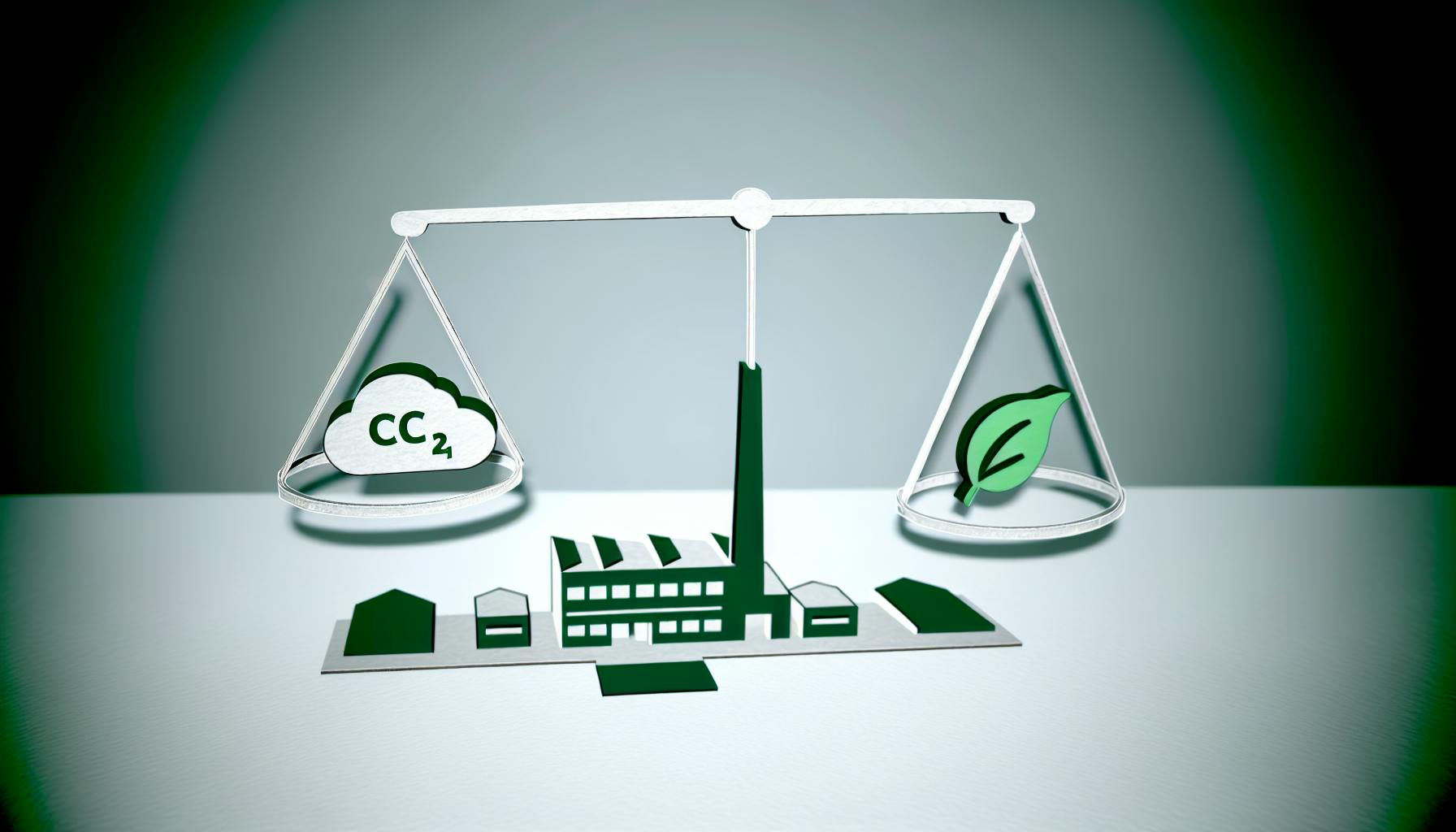Tracking greenhouse gas (GHG) emissions is critical for businesses to understand their climate impact. Most would agree that having visibility into emissions data year-over-year is the first step towards accountability.
This article reviews the latest GHG tracking tools and software that can help small- and medium-sized enterprises easily monitor emissions by year. You'll discover solutions that seamlessly integrate with existing systems while providing actionable insights.
First, we'll explore the importance of annual emissions monitoring and recent trends. Next, you'll learn the basics of Scope 1, 2, and 3 emissions for SMEs. We then analyze sample emissions data over time, including a case study on US CO2 emissions by year. Finally, the article showcases user-friendly tools to track GHG emissions, with lessons learned from SMEs excelling in yearly reporting.
The Importance of Monitoring GHG Emissions Annually
Understanding the Climate Crisis and SME Accountability
The climate crisis poses an existential threat to communities and ecosystems across the globe. As key contributors to greenhouse gas (GHG) emissions, small and medium-sized enterprises (SMEs) have a responsibility to track and reduce their carbon footprint. By monitoring emissions on an annual basis, SMEs can benchmark performance, demonstrate accountability, and make informed decisions to mitigate environmental impact.
Regular emissions monitoring provides the data needed to set science-based targets, assess reduction strategies, and engage stakeholders on progress. For SMEs new to sustainability, annual tracking helps build foundational knowledge of major emission sources, opportunities for improvement, and compliance obligations. As reporting frameworks and regulations continue to evolve, ongoing emissions accounting also ensures SMEs have their finger on the pulse.
The Evolution of GHG Emissions Tracking: A Historical Perspective
The earliest concerted efforts to record GHG emissions using standardized approaches emerged with the Kyoto Protocol in 1997. Since then, frameworks like the Greenhouse Gas Protocol have enabled entities to account for the seven major greenhouse gases across their value chains. While complex and resource intensive at first, advancements in monitoring technology now facilitate automated emissions tracking for SMEs.
From early spreadsheet based calculations to seamless software integrations, the accessibility and accuracy of emissions data has dramatically increased over the past decade. Looking ahead, artificial intelligence and advanced data analytics will further customize insights for emission 'hot spots' and reduction pathways unique to each SME. More affordable and automated tracking empowers small businesses to play their part in mitigating climate change.
How much has greenhouse gases increased over the years?
Greenhouse gas (GHG) emissions have risen significantly over the past few decades.
- Since 1990, global GHG emissions have increased over 60%. Major contributors to this rise include energy production, infrastructure expansion, manufacturing increases, transportation emissions, and changes in land use patterns.
- Carbon dioxide accounts for roughly 75% of total GHG emissions. As such, rising CO2 levels have been the predominant driver of climate change.
- Other major GHGs like methane and nitrous oxide have also grown considerably, further exacerbating global warming.
- The graph below from the EPA shows the dramatic rise in US GHG emissions between 1990 and 2019, the most recent year for which full data is available. After a brief decline around 2012, emissions have rebounded upward over the past decade.
Tracking and understanding historical GHG emission trends is crucial for SMEs looking to benchmark performance, set reduction targets, and decarbonize operations over time.
How much GHG is produced each year?
Greenhouse gas (GHG) emissions vary from year to year globally. According to the U.S. Environmental Protection Agency (EPA), in 2021 total GHG emissions in the United States were approximately 6.3 billion metric tons of carbon dioxide equivalents. This represents a decrease of about 1.7% from 2020 levels.[^1]
The EPA tracks annual GHG emissions and removals in the official U.S. Greenhouse Gas Inventory. This report summarizes total emissions as well as emissions broken down by economic sector. Some key highlights for U.S. GHG emissions in recent years include:
- Transportation and electricity generation accounted for over half of total GHG emissions in 2021
- Between 1990 and 2021, total GHG emissions increased by 1.8%. However, emissions decreased between 2019 and 2021 likely due to impacts from COVID-19
- Changes year-to-year can be influenced by factors like energy consumption, regulations, economic trends, weather patterns, and more
For small and medium enterprises (SMEs), tracking annual GHG emissions is an important way to benchmark sustainability efforts over time. Solutions like EcoHedge provide user-friendly tools to automate emissions tracking each year. This allows companies to set science-based targets, identify reduction opportunities, and report progress to stakeholders. Consistent annual tracking and verification also builds credibility for an organization's net zero commitments.
Overall, comprehensive GHG inventories like the EPA's report provide helpful macro-level emissions data year-over-year. For SMEs focused on reducing their climate impact, granular tracking tailored to their individual operations is key. Sustainability-as-a-service solutions can simplify this process considerably.
[^1]: Inventory of U.S. Greenhouse Gas Emissions and Sinks | US EPA
Are greenhouse gas emissions increasing 2023?
According to climate research institute CICERO, global carbon dioxide emissions are expected to increase by around 1% in 2023 compared to 2022, potentially reaching an all-time high.
This continues the upward trend in greenhouse gas emissions that has been observed over the past decade, indicating that progress on climate change mitigation remains insufficient. Tracking tools that measure GHG emissions by year are essential for organizations seeking to understand their carbon footprint over time and identify opportunities to curb emissions growth.
For small and medium-sized enterprises (SMEs), solutions like EcoHedge provide automated and accurate emissions data that is easy to integrate into existing business processes. By establishing annual GHG inventories, companies can set emissions reduction targets aligned with climate science, engage stakeholders on sustainability performance, and make informed decisions to reach net-zero.
As global emissions are projected to rise in 2023, the need for climate action becomes increasingly urgent. Reliable GHG tracking empowers SMEs to benchmark yearly progress and sustain decarbonization efforts over the long term.
Are GHG emissions increasing?
GHG emissions have been steadily rising over the past few decades. According to data from the EPA, total U.S. greenhouse gas emissions increased by 1.3 percent from 1990 to 2019. The primary culprit is carbon dioxide emissions from burning fossil fuels like coal, oil, and gas.
In 2019 alone, U.S. GHG emissions totaled 6,577 million metric tons of carbon dioxide equivalents. This represents a 2.2 percent increase from 2018 levels. When examining the data year-over-year, we see an upward trend in emissions over the past decade, with a few exceptions.
For example, emissions decreased from 2007 to 2009, likely due to the economic recession. They rose again from 2009 to 2019, with year-over-year fluctuations. Overall, the data shows a contrasting picture to the urgent need for rapid decarbonization to avoid the worst impacts of climate change.
Reducing GHG emissions remains an ongoing challenge. To track and benchmark progress, tools like ghg emissions by year data and graphs provide important insights. For SMEs starting the net zero journey, this emissions baseline is essential for setting science-based targets and monitoring decarbonization efforts over time. Easy to use SaaS solutions can integrate ghg emissions by year tracking seamlessly into existing business workflows. This enables data-driven decisions toward critical emission reductions in line with 1.5°C pathways.
sbb-itb-0f1f828
The Basics of GHG Emissions for SMEs
Understanding greenhouse gas (GHG) emissions is key for SMEs looking to reduce their carbon footprint. Tracking emissions over time allows companies to set reduction targets and make informed decisions.
Decoding Scope 1, 2, and 3 Emissions
The Greenhouse Gas Protocol separates emissions into three categories based on the level of control a company has over them:
- Scope 1 covers direct emissions from owned or controlled sources like vehicles and equipment. These are the easiest to track and reduce.
- Scope 2 covers indirect emissions from the generation of purchased energy like electricity or heating. Though external, these can also be accurately tracked and reduced.
- Scope 3 covers all other indirect emissions from the supply chain and customer use. These are the most complex to measure but often the most significant.
Getting clarity on scope definitions is crucial when compiling a GHG inventory.
From Raw Data to Insights: The GHG Inventory Process
Conducting a GHG inventory involves gathering emissions data, organizing it by scope, and analyzing trends over time. Key steps include:
- Collecting activity data like fuel and energy usage
- Calculating emissions using published emissions factors
- Comparing year-over-year emissions to set reduction targets
- Identifying hotspots for reduction initiatives
- Reporting to stakeholders on progress
Automated software can simplify data collection and provide actionable insights from the inventory. Overall, developing a rigorous annual GHG inventory builds the foundation for emission reduction strategies.
Trends in GHG Emissions: Analyzing Data Over Time
GHG emissions data provides crucial insights that inform sustainability strategy and climate action plans. Analyzing emissions trends over time allows companies to track progress, benchmark against targets, and make data-driven decisions. Visualizing GHG data also enables effective communication with stakeholders about sustainability performance.
GHG Emissions by Year Graph: Visualizing Progress
Graphs demonstrating GHG emissions by year can quickly convey whether a company's climate efforts are headed in the right direction. Year-over-year comparisons make emitting sources and reduction opportunities apparent over time. Easy-to-understand visuals also help company leaders monitor performance vs. goals and relay sustainability achievements to customers, investors, and employees.
Integrating graphing capabilities into GHG tracking software eliminates manual chart creation and keeps visuals dynamically updated. Automating graph generation also provides flexibility to filter emissions data (e.g. by scope, facility, region) for customized analysis. As visual storytelling grows more crucial in sustainability communications, GHG emissions graphs help transform complex data into compelling narratives of climate progress.
Benchmarking Against the GHG Emissions by Year 2020 Milestone
The year 2020 carries symbolic weight in the climate community as a checkpoint for tangible emissions reductions. Under the Kyoto Protocol, developed nations pledged to cut GHGs by 2020 vs. 1990 baselines. Now beyond this target date, comparing current emissions to 2020 serves as an informal progress benchmark for companies pursuing net zero trajectories aligned with climate science.
Software solutions that incorporate both user-defined and standardized 2020 comparisons empower sustainability teams to easily contextualize their abatement efforts. This benchmarking assists strategic decisions by quantifying emissions performance against a recognized climate milestone. Overall, framing emissions trends in relation to 2020 provides a broadly meaningful indicator of the pace and scale of climate action for both internal and external audiences.
Regional Emissions Insights: The Case of U.S. CO2 Emissions by Year
The trajectory of U.S. CO2 emissions over the past several decades provides a useful benchmark for SMEs to evaluate their own emissions profiles. As the world's largest economy with a diverse mix of industries, America's emissions history reflects the broader relationship between economic growth, policy changes, energy shifts, and GHG emissions at a macro level.
Analyzing graphical representations of U.S. emissions data can help SMEs contextualize their performance and identify opportunities for improvement.
U.S. Carbon Emissions by Year Graph: A Comparative Analysis
U.S. CO2 emissions from fossil fuel combustion peaked in 2007 at just over 6 billion metric tons. Since then, emissions have declined by 12% to 2020 levels. This downward shift since 2007 has been driven by a range of factors, including:
- Declining reliance on coal for electricity generation
- Improving vehicle fuel efficiency standards
- Broader transition from a manufacturing to services economy
For SMEs seeking to reduce emissions, studying U.S. emissions trends prompts some key questions when evaluating their own performance:
- How do our emissions per unit of economic output compare historically and relative to sector benchmarks?
- Can we attribute past GHG reductions to any structural economic changes in our business?
- What is the split of emissions between electricity usage and other sources?
Having internal clarity on these aspects provides stronger context for managing ongoing emission performance.
Understanding Policy Impacts on U.S. Emissions Trends
Changes in U.S. policy environments have also substantially impacted national emissions over recent decades. Implementation of the Clean Air Act empowered the Environmental Protection Agency to set more stringent standards related to GHG emissions. Fuel efficiency rules for the transportation sector also yielded progress in mitigating emissions growth relative to economic expansion.
For SMEs tracking annual emissions in their GHG inventories, changes to U.S. regulations could introduce new compliance requirements. Developing a structured approach to inventory management enables SMEs to more readily adapt as policies evolve. Prioritizing emissions visibility and verifiability positions companies to respond effectively if or when new regulatory measures are enacted.
Proactively monitoring U.S. emissions policy changes also allows SMEs to identify federal incentives that could support investment in energy efficiency and renewable energy programs. Optimizing these opportunities provides a mechanism to align emissions management objectives with sources of external funding or tax relief.
Digital Solutions for GHG Emissions Tracking
Companies today need effective tools to track and report their greenhouse gas (GHG) emissions over time. As climate change concerns grow globally, businesses face increasing pressure from regulators, investors, and customers to disclose their carbon footprints annually and demonstrate progress on emissions reductions. However, the complexities of emissions calculations can make year-over-year tracking difficult without the right software solution.
Selecting the Right Software for Yearly Emissions Tracking
When evaluating carbon accounting tools to manage evolving GHG data, small and medium-sized enterprises (SMEs) should look for a few key features:
- Automated emissions calculations: Manual calculation of Scope 1, 2, and 3 emissions is time-consuming and prone to errors. Automated software can seamlessly pull data from various sources and provide customized emissions factors for accurate carbon accounting.
- Flexible reporting: Companies need to report emissions data in different formats to meet various compliance needs or stakeholder requests. The ability to easily generate reports by year, scope, or business division saves significant reporting time.
- Data quality checks: Software with built-in data validation helps identify missing data or anomalies in emissions sources, reducing the risk of incorrect carbon accounting.
- Visual data analysis: Charts and graphs that illustrate emissions by source or over time allow for quicker insights into carbon hotspots and progress.
- Scenario modelling: The ability to forecast emissions under different business scenarios enables more informed carbon reduction strategies aligned with operational realities.
Choosing software with these key features ensures SMEs can efficiently and accurately track yearly emissions despite business fluctuations or reporting changes.
Integration with Existing Systems: Streamlining Emissions Management
To save time and effort, the selected annual emissions tracking software should seamlessly integrate with a company's existing operational systems like energy, transportation, purchasing, or ERP platforms.
Integrations avoid manual duplication of data inputs across systems. Automated data syncing also minimizes risks of human error in transferring emissions-related data between platforms. This streamlines the overall emissions tracking process.
Consider software solutions that offer pre-built integrations with common business tools or custom integration support. As a company's carbon accounting needs grow in complexity, having expandable software that integrates additional data sources will ensure flexible and scalable emissions management over time.
Prioritizing integrations lays the technology groundwork for efficient, automated GHG tracking year after year – essential for SMEs on the net zero journey.
Case Studies: SMEs Excelling in GHG Emissions Tracking
SMEs face increasing pressure from stakeholders to measure and reduce their greenhouse gas (GHG) emissions. Implementing a robust emissions tracking system is key to identifying high-impact areas for reduction. These case studies showcase SMEs that have successfully tracked yearly emissions, driving innovation and continuous improvement.
Innovative Approaches to Annual Emissions Reduction
California-based tech startup EcoAnalytics began tracking scope 1 and 2 emissions in 2018 using both manual data collection and integrated sensors. By analyzing the data yearly, they identified that server rooms accounted for nearly 40% of emissions. In response, they implemented a virtualization initiative, consolidating servers and upgrading cooling systems. This led to a 32% decrease in emissions the following year. Their detailed tracking enabled targeted reduction strategies.
UK-based manufacturer GreenMachines systematically tracks scope 1, 2, and 3 emissions using automated software. The yearly reporting consistently showed transportation as a top contributor. In 2021 they launched an initiative to optimize logistics networks, reducing miles traveled by 36% annually. They continue innovating, with a project to integrate low-carbon concrete into operations projected to decrease scope 3 emissions by 29% by 2025. Their yearly tracking and analysis fuels continuous innovation.
Lessons Learned from Yearly GHG Emissions Reporting
Many SMEs find conducting an initial GHG inventory daunting. However, persistent yearly measurement builds capacity and yields insights that drive strategic emissions reductions.
Swiss engineering firm ZetaTech learned the value of high-quality data inputs. Their first year of reporting using estimated data showed a 12% decrease in total emissions. However, the next year’s report integrating measured data actually showed a 4% increase. This highlighted the need for accurate tracking to correctly identify trends.
Canadian agribusiness GreenFarm initially found it difficult to collect scope 3 data from suppliers. By communicating data requests during contract renewals, emphasizing the value of sustainability insights, they have increased response rates from 32% to 68% over 3 years. Their improved datasets enable more targeted upstream initiatives.
Detailed emissions tracking builds internal expertise over time. SMEs that consistently track and analyze emissions yearly build knowledge and capacity to drive innovative reductions.
Conclusion: Embracing Transparency and Action
As SMEs increasingly come under scrutiny for their environmental impact, tracking GHG emissions accurately on a yearly basis is no longer just best practice - it's an imperative. Tools that consolidate and simplify emissions data provide clarity that benefits companies, investors, policymakers and the planet alike.
The Road Ahead for SMEs in Climate Accountability
The expectations for climate accountability will only increase for companies of all sizes in the years ahead. Policy developments and investor priorities will likely mandate more robust emissions disclosures from SMEs specifically. Starting the emissions tracking journey now with solutions that integrate smoothly puts SMEs in the best position to comply and engage stakeholders.
As reporting frameworks and regulations evolve, SMEs would benefit from emission tracking tools that can adapt quickly. Opting for automated and full-service software solutions means the tool providers update methodologies on the back-end so SMEs can focus resources elsewhere.
Best Practices for Continuous GHG Monitoring
- Prioritize accuracy - Estimating emissions leaves too much room for doubt. Leveraging accurate activity data in emissions calculations influences strategy.
- Monitor across Scopes 1, 2 & 3 - Holistic insights require tracking all emission sources, not just operations. Include value chain impacts.
- Focus on year-over-year trends - Current emissions matter, but the trajectory over time determines progress. Tracking yearly changes highlights what strategies work.
- Partner with specialists - Regulations and stakeholder needs will shift. Software partners intimately focused on emissions space can continuously enhance tracking tools on SMEs behalf.
Reliable emissions data enables sustainability action. As pressure mounts, SMEs would do well to embrace transparency now and enlist tools specialized to the task. The years ahead will reward those who act decisively with enduring stakeholder trust.



.png)


